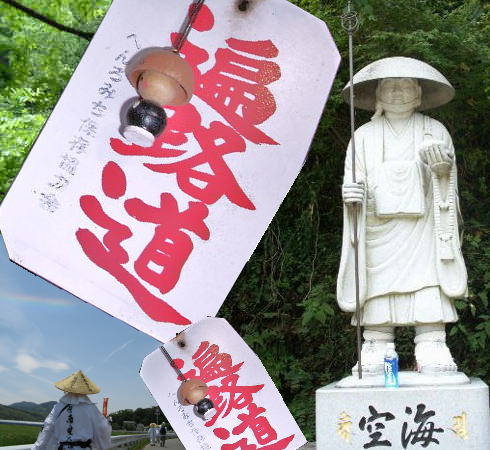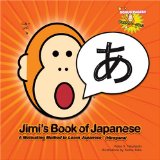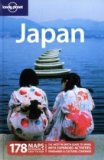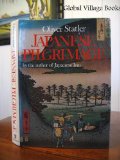HENRO (PILGRIMAGE) to the 88 Sacred Temples of Shikoku
If you have time, we highly recommend that you should make a pilgrimage there. The trail is about 1,400km and it takes about 2 months on foot, about 3 weeks by bicycle, one week by scooter or car.
Even though you may not be a Buddhist, you can try the great journey as lots of nonreligious Japanese people are traveling as pilgrims there. That is for sure that it will be one of the greatest journey you make in your life!!
The real beauty of Shikoku is the remaining nature which can easily be seen when one goes a bit deeper inland and takes the narrower roads in the mountain areas and gorges; any place which is not famous enough to be a touristic spot.
Even though you may not be a Buddhist, you can try the great journey as lots of nonreligious Japanese people are traveling as pilgrims there. That is for sure that it will be one of the greatest journey you make in your life!!
The real beauty of Shikoku is the remaining nature which can easily be seen when one goes a bit deeper inland and takes the narrower roads in the mountain areas and gorges; any place which is not famous enough to be a touristic spot.
 |
The former names are still in common use in Shikoku.
Ehime was Iyo, Kagawa was Sanuki, Tokushima was Awa and Kochi was Tosa.
The Origin of Henro and summery
Henro-tabi is a pilgrimage to walk to the 88 sacred temples clockwise around Shikoku.It is believed all 88 temples were visited by the famous Buddhist monk Kobo Daishi (774-835) who is known as Kukai and the founder of the Shingon sect; After Kukai passed away, Shikoku Henro (Pilgrimage) was started by monks of Shingon sect to follow in the footsteps of the great Buddhist saint Kukai around the end of Heian period.
Therefore, it’s said that the pilgrimage to the 88 sacred temple of Shikoku is a travel to follow in his footsteps: Henro doesn’t travel alone, Henro is always with Kobo Daishi.
Kongo-zue (a wooden walking stick) which is used by Henro is regarded as Kobo Daishi and must be treated most respectfully on the way. In fact, Hernro write down “同行2人 (Dogyo-ninin) ‘two people are going together‘“ in a form of a hotel book when he/she checks in, even though he/she stays alone: One is alone, but with Kobo Daishi.
To travel clockwise is called “順打ち ‘Jun-uchi’”, to travel counterclockwise is called “逆打ち‘Gyaku-uchi’” and to finish visiting all of the 88 temples is called “満願‘Mangan’ or 結願 ‘Kechigan’”.
It’s believed that Gyaku-uchi (to travel counterclockwise) can give Henro 3 times more prayer answered (benefit) than the one by Jun-uchi (to travel clockwise), as the guide boards are less and poor, in addition, the route make the travel harder.
“通し打ち‘Toshi-uchi’” means the whole pilgrimage to the 88 temples is done at once; “区切り打ち ‘Kugiri-uchi’” means to finish the whole pilgrimage to the 88 temples in several stages for a long time.
How to get started
The route starts at Temple 1, the Ryozenji in the northern part of Tokushima city and Henro (pilgrim) also have to return here to complete the circle. It generally said that it’s better to visit Mt. Koya in Wakayama prefecture where Kobo Daishi is enshrined before/after the pilgrimage to Shikoku Henro. There are actually 89 temples (because you have to go back to the first temple which you started at), plus Okunoin on Mt. Koya (one time after Henro or twice before/after Henro).It’s not necessary to make a pilgrimage in order, as long as one visits them all, but Temple 1, the Ryozenji is by far the most popular starting point for pilgrims from outside Shikoku.
Get ready to set off for pilgrimage, buying all the gear you need (outfits for a pilgrim are available at Temple 1, the Ryozenji, some other temples and online-shops).
You visit a temple of the 88 temples, offer prayers at the main hall and the Daishido hall, offer your osamefuda paper name card at each hall, get a stamp, go to another temple, do the same, find a place to sleep at the end of the day, go to sleep and next day repeat the same routine until you get to the last temple.
How long and how far
The entire walking route is 1200km and the cycling route is about 1400km.The walking route is often shorter than the one for cycling, as the route for walking pilgrims can be like a shortcut through the mountains, while cyclists often take roundabout routes.
Visiting all the temples on foot takes about 1 month (very fast) to two months (those who enjoy the travel itself); by bicycle takes 2 weeks (very fast) to 1 month; by car takes 9-10 days; by tour bus takes about 2 weeks; by motorcycle takes about 1 week to 9 days.
How long to take changes depending on your fitness and whether or not you do Nokyo (getting stamps--See What is Nokyo) at Nokyo-sho (a place where a pilgrim gets stamps).
The opening time for Nokyo is 7am and the closing time is 5pm. If you do Nokyo, you probably want to set off around 5am in the morning so you can get to the first temple of the day by 7am.
Even though a pilgrim is used to Henro or not, it takes about 30 minutes until he/she can go to Nokyo-sho after worship at each temple. It takes only a minute, if you do nothing and even don’t go to the main hall, except you go to the Nokyo-sho straight right after you arrive, though…
Where to sleep
Those who stay at accommodations anticipate where to get by the end of the day and make reservations for places to stay in advance while walking. However, many places can be fully booked during the on season.Those who stay outside should only to find a place to sleep outside or to set up their tents: Benches at a park; Zenkon-yado (a free accommodation for walking or cycling pilgrims); public bath rooms; bus stops; rest huts for Henro. Some of bus stops, parks and public bath rooms are maintained for Henro with kind consideration, so pilgrims can stay and sleep: for example, a bus stop with a lock; a public bath room with a wide and long bench; a tatami matted bench at a bus stop.
What is Ofuda (Osame-fuda)?
Ofuda is a special name card.Write your name, address and the date when you visit the temple on the ofuda, and put your ofuda in the box for ofuda at the main hall and the Daishido.
White osanefuda are used by those on their first to fourth pilgrimage, blue for the fifth to sixth, red for the seventh to twenty-fourth, silver for the fiftieth to ninety-ninth and gold for hundredth and more.
It is believed that one can get good luck beyond the realm of normal probability, if one gets a gold osamefuda; sometimes you might see shame acts like someone is putting his or her head into the osamefuda box to search for a gold osamefuda.
Even though you don’t conduct yourself poorly, if you make a pilgrimage properly, you will be given by henro who has it meanwhile…
Ofuda is also used as a name card to exchange with people you meet on the road or a thank-you card when you get O-settai (see O-settai) in return.
What is Nokyo
Nokyo-cho is a special book in which one collects the fine calligraphy and vermilion seals of every temple. It is your record that you visited each temple. Some people might regard it as a stamp collecting race or something, but as nokyo means that one truly recited a sutra at the temple, it must get stamped after reciting a sutra at the Hondo (main hall) and the Daishido.A Nokyo-cho book costs about 1000-2000yen.
Nokyo (to get it stamped) 300yen/temple: 300yen x 88 temples + 300yen (to go back to the first temple) + 300yen (Okunoin on Mt. Koya) = 27,000yen
Nokyo-sho (Nokyo office) is open at 7am in the morning and closed at 5pm in the evening.
There are also a scroll and a Byakue (special white uniform for henro) to collect the stamps. The stamp for a scroll costs 500yen per temple and for a Byakue costs 200yen per temple.
O-settai
O-settai is the giving of a gift of food, drinks, occasionally money or a place to stay from a non-"henro" to a "henro".The story behind the history is that locals would give food and drinks to henro (pilgrims) passing through the village, because they didn’t want henro to die in their village as they had to pay for the funeral, and that they expected that henro should die in another village. However, now a day, most of the people offer 0-settai as their personal kindness or a few do that from their devotion.
Generally speaking, those who offered O-settai can get 3 times more benefit the pilgrims who were given can get, or those who can’t make a pilgrimage because of their old age or physical disability place their hope on O-henro-san (pilgrims) who can make pilgrimages for them. In that sense, basically henro must (or should) get O-settai and shouldn’t refuse. However, many pilgrims who want to walk all the way without a ride by themselves, they might refuse the offer politely when they were asked to have rides.
O-settai system in Shikoku might sounds like old habit and it doesn’t exist anymore, but people in Shikoku often offer O-settai even now. You might be moved to tears when you feel their kindness on the road one day.
As a sign of politeness, you should give your Ofuda (special name card) to the person who offered O-settai in return.
What to wear
You don’t need to wear the perfect henro outfits, but most of pilgrims tend to wear at least the white uniform (Byakue), the sedge hat (Sugegasa) and a wagesa (at temples, see the picture), and have the wooden walking stick (Kongo-zue) and pouches.People usually go in sportswear or everyday clothes, in sneakers and sun visors and not a few try to wear white clothes.
The sedge hat (Sugegasa) is very useful for walking henro as it can make one feel cool or avoid from raining, while it’s absolutely out of question for a bike henro to wear it as it can work like a parachute.
What to do at a temple
* General case*Bow at the gate at the entrance (Niōmon or Sanmon).
Rinse your hands and mouth at the ablution basin to cleanse of yourself
Strike the bell (Tsurigane) announcing one's arrival to the temple divinities and Kobo Daishi. (Don’t strike the bell when leaving)
Tidy yourself and put on a wagesa (see What to wear).
At the Hondo (the main temple hall), light votive candle, offer incense, put your Osamefuda into the box and toss offerings of money (normally 5yen) into the box. Strike the bell at the Hondo. (Don’t strike it when leaving) Chant sutras (see The order to chant sutras).
At the Daishido, do the same as things to do at the main hall.
Visit all the halls in the temple. (Most of the people visit only the main hall and the Daishido.)
Get your Nokyo book stamped at the Nokyo-sho (stamp book office)
Bow at the Sanmon gate. (You have to turn around!! Face the temple!!)
Make the effort to do almost all the things in the list above, in order to know and understand the real world of the Shikoku pilgrimage. You even should chant at least “Hannya Shingyo ‘Heart Sutra’” in Japanese at every temple. Hannya Shingyo is one of the oldest and most famous of all chants in Japanese Buddhism. It is short and simple and supposedly contains all the truths one needs to know. It is chanted in “on” reading way (Chinese reading), even almost all the Japanese people don’t understand when they hear the sutra in “on“ reading way.
You might be hesitated to chant a sutra in Japanese or might be shy to do other things. However, you will notice that all of these things can make you relaxed, appealing to your senses, some time after you start doing them: The candle flame for eyesight; The incense for smell; The sound of chanting sutras for hearing.
Also, the abdominal breathing while chanting sutras in a uniform rhythm is good for your health.
One more point to remember: Even the Japanese have no idea about the meaning of Hannya Shingyo from the sound of “on“ reading, don’t be shy to chant it in Japanese. Chant it as if you were the best Hannya Shingyo chanter!! (Check how to read it on the page of “The Order to chant sutras”)
The Order to chant sutras
*General exampleAt the Hondo (main hall)
Bow with your hands clasped in prayer
Kaikyoge (開経偈) -- one time
Hannya Shingyo (般若心経) -- one time
Gohonzon Shingon (御本尊真言) -- three times
Koumyo Shingon (光明真言) -- three times
Gohougou (御宝号) -- three times
Ekoumon (回向文) -- one time
Say “Arigatogozaimasu (Thank you very much)”
Bow with your hands clasped in prayer
At the Daishido
Bow with your hands clasped in prayer
Kaikyoge (開経偈) -- one time
Hannya Shingyo (般若心経) -- one time
Koumyo Shingon (光明真言) -- three times
Gohougou (御宝号) -- three times
Ekoumon (回向文) -- one time
Say “Arigatogozaimasu (Thank you very much)”
Bow with your hands clasped in prayer
At the Daishido, do the same for the Hondo except the Gohonzon Shingon, because the Gohonzon Shingon is for the image which is enshrined at the Hondo.
It is basically free style, but Hannya Shingyo and Gohougou which is for Kukai (Kobo Daishi) shouldn’t be cut out.
To download the sutras written in Roman character, click on each sutra listed above.
About Henro
Why to goWhen to go
How much does it cost?
Sutra
Henro Travel Reports
Where do you want to go in Shikoku?
Shikoku Henro (Shikoku Pilgrimage)
How to get to and around Shikoku
From Kansai international airportShinkansen route
Japan Railways
Highway bus route
Subway lines in Kansai
Buses in Shikokui
What you need in Japan and before/after in Japan
 |
 |
 |
 |
 |
 |
Find more...